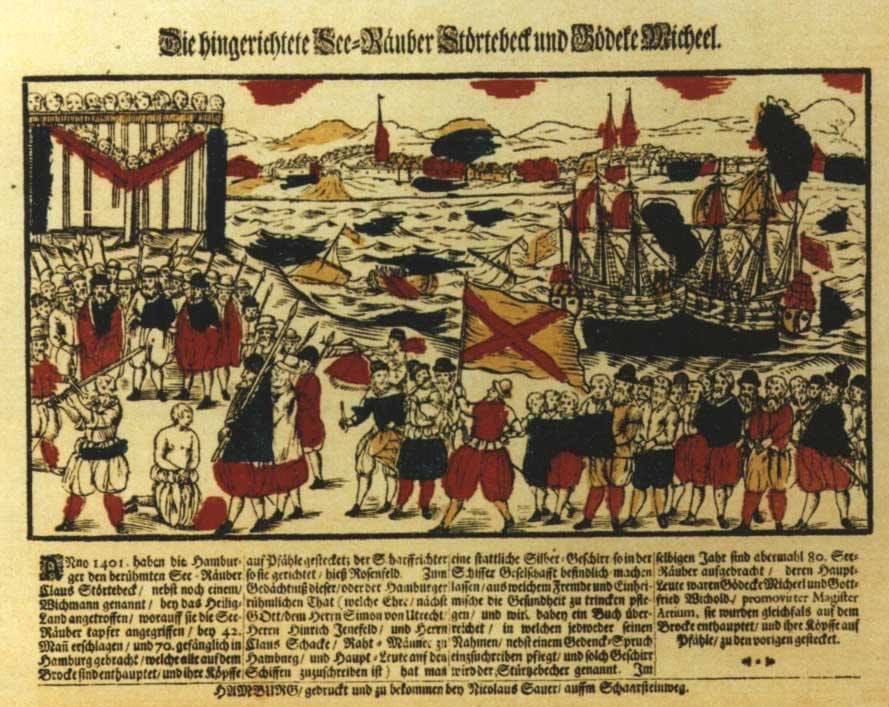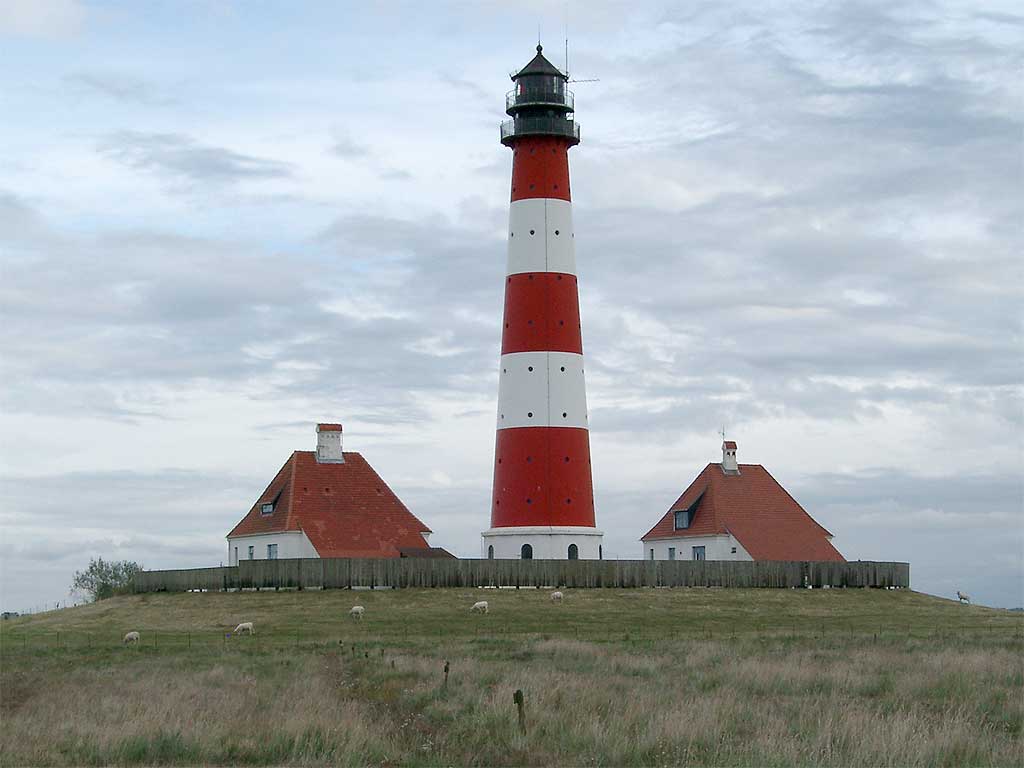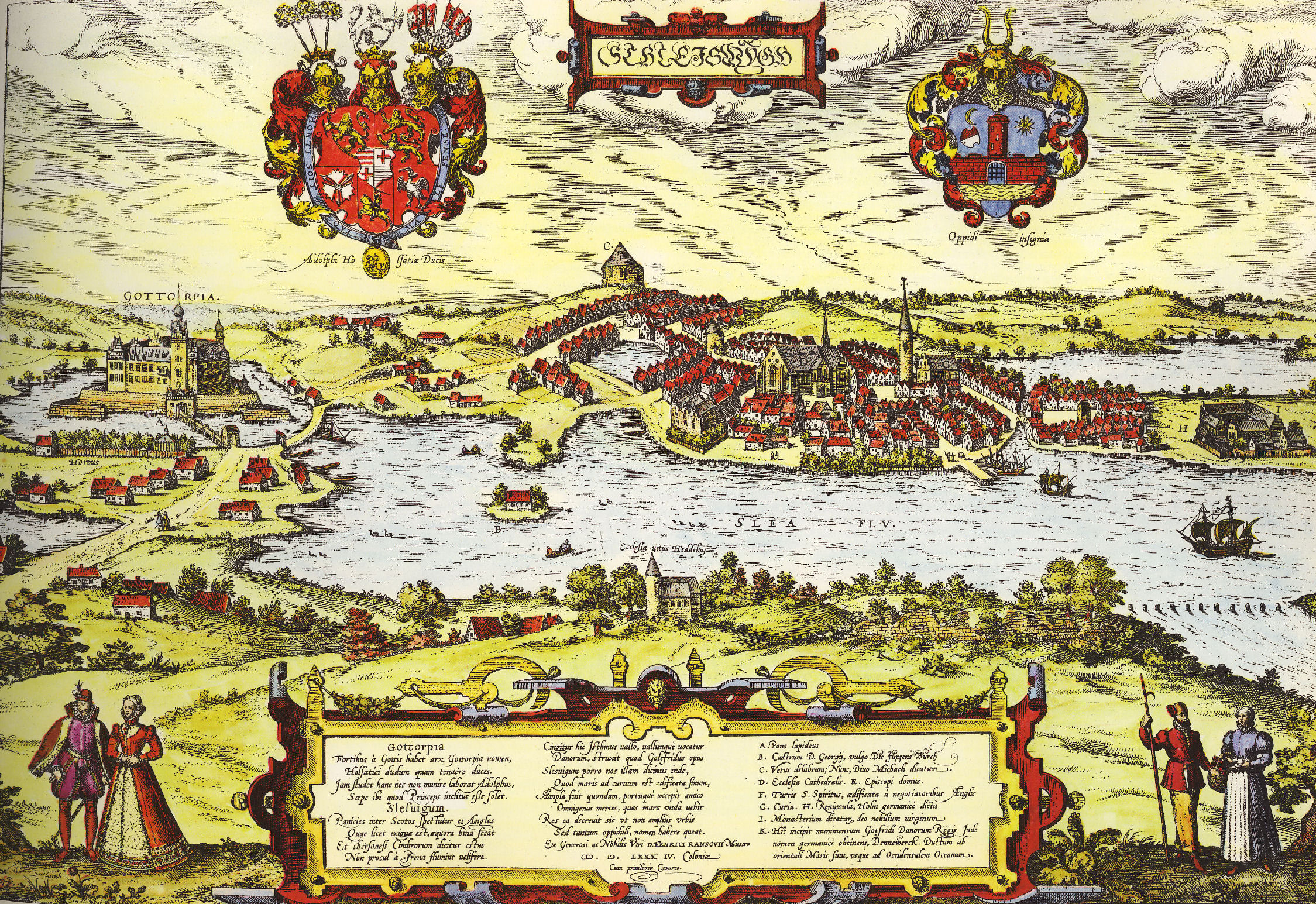|
Henry IV, Count Of Holstein-Rendsburg
Henry IV, Count of Holstein-Rendsburg (1397 – 28 May 1427) was Count of Holstein-Rendsburg and Duke of Schleswig from 1404 until his death. Life Henry was the son of Gerhard VI of Holstein and Catherine Elisabeth of Brunswick-Lüneburg (d. 1417/1422) from the Holstein-Rendsburg line of the House of Schauenburg. His father, Gerhard VI, fell in battle on 4 August 1404 during an attempt to conquer Dithmarschen. Henry was seven years old at the time; his mother took up his guardianship, while the regency was taken up by his uncle Henry III. Henry III had been at war with Denmark since 1408 over the Duchy of Schleswig. Henry III claimed it as a hereditary fief; the Danish Margaret I and later Eric VII, wanted the duchy for themselves. In 1413, the regency ended. Henry IV, together with his younger brothers Adolf VIII and Gerhard VII, continued the war with Denmark. In 1417, a cease fire was agreed, after mediation by the city of Lübeck. In 1423, the war continued. On 2 ... [...More Info...] [...Related Items...] OR: [Wikipedia] [Google] [Baidu] |
House Of Schauenburg
The House of Schaumburg was a dynasty of German rulers. Until c. 1485, it was also known as the House of Schauenburg. Together with its ancestral possession, the County of Schaumburg, the family also ruled the County of Holstein and its partitions Holstein-Itzehoe, Holstein-Kiel, Holstein-Pinneberg (till 1640), Holstein-Plön, Holstein-Segeberg and Holstein-Rendsburg (till 1460) and through the latter at times also the Duchy of Schleswig. History The Schaumburgs were named after Schaumburg Castle, Lower Saxony, Schauenburg Castle, near Rinteln on the Weser, where the owners started calling themselves Lords (from 1295 Counts) of Schauenburg. Adolf I, Count of Holstein, Adolf I probably became the first Lord of Schauenburg in 1106. In 1110, Adolf I, Count of Holstein, Adolf I, Lord of Schauenburg was appointed by Lothair, Duke of Saxony to hold Holstein and Stormarn (gau), Stormarn, including Hamburg, as fiefs.Lemma Schauenburg/Schaumburg. In: Klaus-Joachim Lorenzen-Schmidt, Ortwin ... [...More Info...] [...Related Items...] OR: [Wikipedia] [Google] [Baidu] |
Adolf VIII, Count Of Holstein
Adolphus XI of Schauenburg ( nds, Alef or Alv, german: Adolf von Schauenburg, da, Adolf 8. af Holsten-Rendsborg) (1401 – 4 December 1459), as Adolph I Duke of Schleswig ( da, Sønderjylland, formerly ), and as Adolph VIII Count of Holstein-Rendsburg, was the mightiest vassal of the Danish realm. Background Adolph descended from a branch of the House of Schauenburg, who had for centuries been counts of Holstein, and as such, vassals of the Holy Roman Empire. His great-grandfather Gerhard the Great, having also been a Regent of the Kingdom of Denmark, had received the Duchy of Sønderjylland from the Danish crown as a hereditary fief. It had been lost for the Schauenburgs between 1330 and 1375, with Queen Margaret I of Denmark restricting the regained ducal power in 1386, and again from 1414 to 1440. Count Adolph's parents were Gerhard VI, Count of Holstein-Rendsburg and Catherine Elisabeth of Brunswick-Lüneburg. Adolph was only three years old when his father was killed ... [...More Info...] [...Related Items...] OR: [Wikipedia] [Google] [Baidu] |
Ingeborg Of Mecklenburg
Ingeborg of Mecklenburg (1343/45 – 25 July 1395) was a daughter of Albert II, Duke of Mecklenburg and his wife, Euphemia of Sweden. Euphemia was a daughter of Ingeborg of Norway, who was the only legitimate child of King Haakon V of Norway. Thus, Ingeborg of Mecklenburg was Haakon V's great-granddaughter. In 1360, she married Louis VI "the Roman" of Bavaria; she was his second wife. The marriage remained childless. After Louis's death, she married Henry II, Count of Holstein-Rendsburg. They had at least four children: * Gerhard VI, Count of Holstein;Helge bei der Wieden calls him Gerhard V married, in 1391, Catherine Elisabeth of Brunswick-Lüneburg and had issue. * Albert II, Count of Holstein-Rendsburg * Henry III, Count of Schauenburg-Holstein (d. 1421), Prince-Bishop of Osnabrück as Henry I * Sofia of Holstein (1375, Lübeck – 1448); married, in 1398, Bogislaw VIII, Duke of Pomerania (1364–1418) and had issue. References Ingeborg 1343 births 1395 deat ... [...More Info...] [...Related Items...] OR: [Wikipedia] [Google] [Baidu] |
Henry II, Count Of Holstein-Rendsburg
Count Henry II of Holstein-Rendsburg (nickname ''Iron Henry''; – ) was count of Holstein-Rendsburg and pledge lord of Southern Schleswig. He ruled jointly with his younger brother, Count Nicholas (d. 1397). Life Henry was the elder son of Count Gerhard III and Sophia of Werle. Henry was a major European player as a mercenary leader and a typical representative of the late medieval knighthood. He fought in Italy, Russia, Estonia and France. He served in the English and Swedish armies. In 1367, he was commander of a fleet of the Hanseatic League and in 1368, he conquered Copenhagen. Count Henry II and his brother Nicholas vigorously defended their claims in Holstein and Schleswig, against Denmark and against the Frisians. Marriage and issue Henry was married twice: # Matilda (d. 1365), the daughter of Bernard V, Lord of Lippe. They had one daughter: ## Matilda (documented on March 12, 1365) # 1366 Ingeborg (d. 25 Jul 1395), daughter of Albert II, Duke of Mecklenbur ... [...More Info...] [...Related Items...] OR: [Wikipedia] [Google] [Baidu] |
Föhr
Föhr ( ''Fering'' North Frisian: ''Feer''; da, Før) is one of the North Frisian Islands on the German coast of the North Sea. It is part of the Nordfriesland district in the federal state of Schleswig-Holstein. Föhr is the second-largest North Sea island of Germany and a popular destination for tourists. A town and eleven distinct municipalities are located on the island. The climate is oceanic with moderate winters and relatively cool summers. Being a settlement area already in neolithic times, Föhr had been part of mainland North Frisia until 1362. Then the coastline was destroyed by a heavy storm flood known as Saint Marcellus's flood and several islands were formed, Föhr among them. The northern parts of Föhr consist of marshes while the southern parts consist of sandy geest. From the middle-ages until 1864, Föhr belonged to the Danish realm and to the Duchy of Schleswig, but was then transferred to Prussia as a result of the Second Schleswig War. Seafaring has long ... [...More Info...] [...Related Items...] OR: [Wikipedia] [Google] [Baidu] |
Hundred (county Subdivision)
A hundred is an administrative division that is geographically part of a larger region. It was formerly used in England, Wales, some parts of the United States, Denmark, Southern Schleswig, Sweden, Finland, Norway, the Bishopric of Ösel–Wiek, Curonia, the Ukrainian state of the Cossack Hetmanate and in Cumberland County, New South Wales, Cumberland County in the British Colony of New South Wales. It is still used in other places, including in Australia (in South Australia and the Northern Territory). Other terms for the hundred in English and other languages include ''#wapentake, wapentake'', ''herred'' (Danish and Bokmål, Bokmål Norwegian), ''herad'' (Nynorsk, Nynorsk Norwegian), ''hérað'' (Icelandic), ''härad'' or ''hundare'' (Swedish), ''Harde'' (German), ''hiird'' (North Frisian language, North Frisian), ''satakunta'' or ''kihlakunta'' (Finnish), ''kihelkond'' (Estonian), ''kiligunda'' (Livonian), ''cantref'' (Welsh) and ''sotnia'' (Slavic). In Ireland, a similar subdi ... [...More Info...] [...Related Items...] OR: [Wikipedia] [Google] [Baidu] |
Victual Brothers
, native_name_lang = , named_after = french: vitailleurs (provisioners, Hundred Years' War) , image = Vitalienbrueder, Wandmalerei in d, Kirche zu Bunge auf Gotland, gemalt ca. 1405.JPG , image_size = 250px , alt = , caption = A contemporary representation of the ''Vitalienbrüder'' on a wall painting, Bunge church, Gotland, Sweden, , logo = , logo_size = , logo_alt = , logo_caption = , map = , map_size = , map_alt = , map_caption = , map2 = , map2_size = , map2_alt = , map2_caption = , abbreviation = , motto = , predecessor = , merged = , successor = , formation = ca. 1393 , founder = , founding_location = , dissolved = ca. 1440 , merger = , ... [...More Info...] [...Related Items...] OR: [Wikipedia] [Google] [Baidu] |
Eiderstedt
Eiderstedt (german: Eiderstedt, ; da, Ejdersted; North Frisian: ''Ääderstää'') is a peninsula in the district of Nordfriesland in the German federal state of Schleswig-Holstein. Overview It is approximately 30 km in length and 15 km in width and has been created through diking (polders) from three islands: Eiderstedt around Tönning, Utholm around Tating, and Evershop around Garding. The diking started around the year 1000 AD. Since these three islands were administrative districts of their own, the area was originally called ''Dreilande'' - "Three Lands". Alluvial soil won from the North Sea makes the area well-suited for agriculture. At present, tourism dominates, particularly in the city of Sankt Peter-Ording on the peninsula's western tip. The Westerhever lighthouse is the peninsula's main emblem and the most prominent lighthouse in Germany. The Wadden Sea, the Eider Barrage on the Eider River and the Katinger Watt, marshlands won from the sea in the pro ... [...More Info...] [...Related Items...] OR: [Wikipedia] [Google] [Baidu] |
Schleswig, Schleswig-Holstein
Schleswig (, , ; da, Slesvig; South Jutlandic: ''Sljasvig''; nds, Sleswig; archaic English: ''Sleswick'') is a town in the northeastern part of Schleswig-Holstein, Germany. It is the capital of the '' Kreis'' (district) Schleswig-Flensburg. It has a population of about 27,000, the main industries being leather and food processing. It takes its name from the Schlei, an inlet of the Baltic sea at the end of which it sits, and ''vik'' or ''vig'' which means "bay" in Old Norse and Danish. Schleswig or Slesvig therefore means "bay of the Schlei". History The Viking settlement of Hedeby, located south of the modern town, was first mentioned in 804. It was a powerful settlement in the Baltic region, dominating the area for more than 200 years. In 1050, following several destructions, the population was moved to the opposite shore of the Schlei, becoming the city of Schleswig. In 1066 Hedeby was finally destroyed, and Schleswig remained as a part of the Danish kingdom. In 1544, Gottor ... [...More Info...] [...Related Items...] OR: [Wikipedia] [Google] [Baidu] |
Pope Martin V
Pope Martin V ( la, Martinus V; it, Martino V; January/February 1369 – 20 February 1431), born Otto (or Oddone) Colonna, was the head of the Catholic Church and ruler of the Papal States from 11 November 1417 to his death in February 1431. His election effectively ended the Western Schism of 1378–1417. He is the last pope to date to take on the pontifical name "Martin". Biography Oddone Colonna was born at Genazzano, the son of Agapito Colonna and Caterina Conti, between 26 January and 20 February, 1369. He belonged to one of the oldest and most distinguished families of Rome. His brother Giordano became Prince of Salerno and Duke of Venosa, while his sister Paola was Lady of Piombino between 1441 and 1445. Oddone studied law at the University of Pavia. He became apostolic protonotary under Pope Urban VI (1378–1389), and was created Cardinal-Deacon of San Giorgio in Velabro by Pope Innocent VII in 1405. In 1409 he took part in the Council of Pisa, and was one of the su ... [...More Info...] [...Related Items...] OR: [Wikipedia] [Google] [Baidu] |
Sigismund, Holy Roman Emperor
Sigismund of Luxembourg (15 February 1368 – 9 December 1437) was a monarch as King of Hungary and Croatia ('' jure uxoris'') from 1387, King of Germany from 1410, King of Bohemia from 1419, and Holy Roman Emperor from 1433 until his death in 1437, as well as prince-elector of Brandenburg (1378–1388 and 1411–1415). He was the last male member of the House of Luxembourg. Sigismund was the son of Holy Roman Emperor Charles IV and his fourth wife Elizabeth of Pomerania. He married Queen Mary of Hungary in 1385 and was crowned King of Hungary soon after. He fought to restore and maintain authority to the throne. Mary died in 1395, leaving Sigismund the sole ruler of Hungary. In 1396, Sigismund led the Crusade of Nicopolis, but was decisively defeated by the Ottoman Empire. Afterwards, he founded the Order of the Dragon to fight the Turks and secured the thrones of Croatia, Germany and Bohemia. Sigismund was one of the driving forces behind the Council of Constance (1414–1 ... [...More Info...] [...Related Items...] OR: [Wikipedia] [Google] [Baidu] |
_01.jpg)
.jpg)



.jpg)